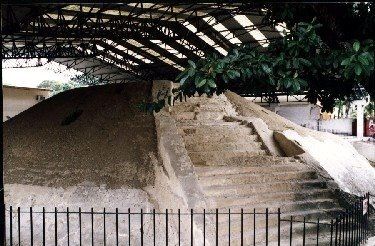Las Flores archaeological zone in Tampico, neighbor of modernity
The case of the Las Flores Archaeological Zone, in the municipality of Tampico, Tamaulipas, is particular due to the context that surrounds it.

Generally, the archaeological zones located in the interior of the country are located in areas relatively far from urban areas or, at least, they are strictly delimited by nearby constructions. However, the case of the Las Flores Archaeological Zone, in the municipality of Tampico, Tamaulipas, is particular due to the surrounding context.
In this zone, located inside the Las Flores residential neighborhood, researchers from the National Institute of Anthropology and History (INAH) in Tamaulipas, work permanently for the conservation and maintenance of the only pyramid it has, since the constructive characteristics that distinguish it and the natural phenomena -storms, hurricanes, and rains- that every year lash the place, cause its gradual deterioration.
The site is made up of 20 mounds, of which only one of the largest is visible; the rest have been identified but have not been excavated because the houses that now make up the colony were built on them, hence the name of the area. And it is that the basement is built with compacted earth, tamped lime, and shell, the reason why its accelerated damage demands periodic observations, as well as works of maintenance that allow its preservation. Oval in shape, its dimensions range from seven meters in height to 28 meters in diameter.
It is possible to observe staircases and stuccoes that, according to the specialists, present a porous aspect, reason for which they considered the possibility that these elements were built with adobe.
From the interventions made in the zone, the archaeologists could affirm that it belongs to the huasteca culture, of the Classic period (1000-1200 A.D.), and among the significant findings, a sculpture of the Goddess of the Fertility or Teem stands out, which is exhibited in the Regional Museum Potosino of the INAH.
Ceramics with geometric motifs typical of the place were also found, in addition to two burials in pairs, that is, skeletons of man and woman, together, accompanied by remains that specialists attribute to guajolotes, an animal that helped, like the dog, the deceased on his way to the underworld.
Another characteristic that distinguishes the area is the roof that was adapted in the nineties to protect it from the climatic changes already mentioned. It is located on Chairel Avenue on the corner of Azahar Avenue, northwest of Tampico's Historic Center, and covers a total of 976 square meters.
Until a few years ago, the pyramid and the perimeter it occupies were used by people as a garbage dump, but thanks to the report and collaboration of some neighbors it was rescued and protected from any other use that could mean its detriment.
It is worth mentioning that not far from this area there is another one known as Tancol, located in the neighborhood of the same name, inside a private school with which negotiations were established for the protection and conservation of the main base, which is 5 meters high.
Tampico is positioned as one of the municipalities that preserves its cultural expressions in the best possible state, despite its proximity to the coast and its constant and aggressive climatic changes, issues that make the preservation of the archaeological vestiges much more difficult.




